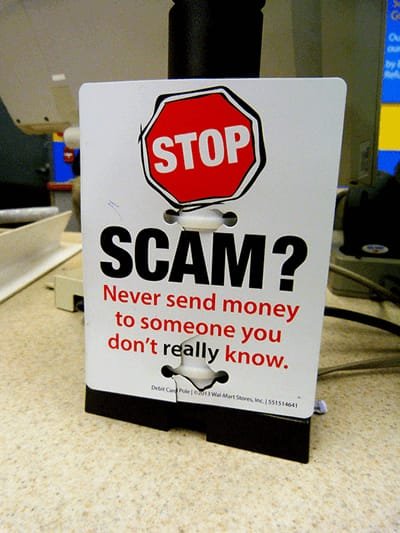WARNING: 3 Cryptocurrency Scams You Must Avoid
The barbarians are at the gate. They’re out there trying to get you, but now you’ve got some ideas on how to protect yourself from all these scams trying to get you from every which way.
What are you going to do with this new-found financial freedom as you embrace cryptos and the blockchain-based future that awaits us all?
You’re going to go out through that gate, past the barbarians and into the world and …
you’re going to get scammed.
Of course not! We’re here to help.
We’ve already talked about all the things that can happen to you, but now we’re going to look at the kinds of scams out there in cryptoland that you can actually get yourself into.
We’re going to tell you exactly what to look for. We can’t catch everything, but by the time you’ve read up on this stuff, and you’ve seen some of these scams yourself, you’ll be an expert.
Fake Bitcoin Wallets
This is something I’ve already talked about, but is a particularly hot scam right at the moment. Remember that ‘spoofing?’ That’s where the scammers duplicate a site as exactly as possible so you think you’re logging in to the real thing? It’s very popular right now to duplicate a wallet app and use a phishing attempt to get the recipient to login to their online wallet.
Then the scammers, of course, have your login info for the real site, and you no longer have the coins that were there. It’s insidious because the sites are sophisticated. They appear just like the original, usually with just some subtle variation of the name, something you probably wouldn’t notice.
But it doesn’t just work with phishing. It works with searches, too. You may make a mistake typing in the wallet name in the search engine or browser search window. They chose that name because it is a common mistype of the wallet name.
And this can be done with a wallet that is just promoted as a new wallet service. People sign up for the new wallet, like how it looks, and then start depositing coins. And that’s that. Scam completed, they got your coins. Who can you complain to? They’ll just string you along with several (fake) service reps and bounce you around until you just give up.
Typically, any info on their site about contacts, phone numbers, names of staff or owners, are all fake. You lose.
As a rule of thumb, only use wallets and exchanges recommended by people and businesses you know and trust, and websites reputable in the industry. The longer they have been around, the better. Once you have an online wallet set up (a real one, that is), save the site in your Favorites. Just use that to access the site. Don’t use search unless you have to, and be careful. Best practices apply.
As a rule of thumb, for new wallets, open source software, vetted by the industry, is generally trustable. The more open source the code is, the better. Someone is always working on a new wallet app. Just be especially careful with new apps until they are fully vetted in the industry.
Don’t deposit large amount of coins, read reviews from known or trusted writers, and stay current in industry news at reputable sites. Test the service – just deposit a small amount and try the service for a while. A good test is to try to withdraw some coins, or even all of what you deposited. If you can do that without any problems, then deposit more later. Let them earn your trust over time. Withdrawal problems are a red flag. It doesn’t always mean scam, but you should be careful.
It’s best to go with recommended products until you know more about the industry, but even the industry can be temporarily fooled.
There have even been several fake wallet apps that have slipped through Apple’s review process and made it into their marketplace – with names and logos that looked legit, completely copied elements of the real businesses, but with links that went to a bogus wallet.
Ponzi
This brings us to the ever-present Ponzi scheme. This scam typically works by promising investors spectacular returns, the kind they can’t pass up. Then, the money from new investors brought in pays the initial investors, making it look like the investment works great. This is what then attracts a whole new, larger, round of investors. The problem is, there’s no real investment. The scam ends when there just aren’t enough investors to keep it going. Then the organizers just run off with all the money that the final investors put in.
In cryptos, the Ponzi found its next great playground.
These scams usually take the form of fake cloud mining schemes, shared profits from a ‘revolutionary’ trading algorithm, or even investor clubs. These are what’s known as an HYIP, a High Yield Investment Program.
Now, technically, cloud mining platforms, shared trading algorithms, and investor clubs aren’t inherently scams. But anyone who has been around cryptos for any length of time has seen so many of these ‘investments’ come and go, and many have even given in and tried one or two of them. They are almost invariably scams.
Typically they will go something like this. You deposit money, buying into some contract where you will receive profits on, let’s say a weekly basis. At first it seems to work as you get your returns. But then there will be a delay in payment. Maybe they will resume, maybe not. Again, who will you complain to? They can string you along if they like.
Eventually, you will try to withdraw your investment only to find you can’t – there’s a technical problem, or it’s not in your contract, or they just plain take your coins and never talk to you again.
Some people intentionally invest knowing it’s a Ponzi scheme. They want to be in early to get the gains that the organizers will pay out to the first investors – they will spread the word and be the first line of defense against accusers of fraud – “but I got paid those returns! I know it works.” They may know the fraudster, or may just be trying to take advantage of the opportunity. People like that make it harder to tell the rip-offs from the real investment opportunities.
There are usually a number of red flags you should look out for. Do they promise ‘guaranteed’ profits? Not too many investments can guarantee profits, especially with the absurdly high rates of return they throw around. What kinds of reviews are they getting from reputable reviewers? Do they have a social media presence? Are the owners and staff accessible? Do they attend trade conferences? Does anyone even know who they are? Are their contracts or mining addresses public? How transparent are they? These are the questions you need to ask, and the answers are usually not satisfactory.
If it sounds too good to be true, it probably is. If they were making such great returns, why would they need your money to do it? The bottom line is – if they were, they probably wouldn’t even tell anyone about it, let alone share the profits with strangers.
It’s possible that you can find some good investments out there. Just do your research first, and expect the worst if you do invest. If it actually works out, congratulations.
Bitcoin Donation Scams
This one is as bad as it sounds. People will go to great lengths, and without a shred of moral decency, to get your coins. These scams can be as sophisticated as a great-looking website with lots of heart-wrenching stories of hungry children and needy puppies. Of course, they can cut-and-paste those stories from legitimate charities, and get those puppy pictures from free stock photo sites just like we could.
Or they can be as simple as a Retweet or Facebook post asking you to send some coins to help their great cause. They’ll even give you the address to send it to. It’s so easy! Please don’t fall for it. Either donate only through established charities or at least do some work reviewing their project using the safeguards we will supply you with in this report.
For now, keep your eyes open, start doing research as you see potential scams or potential investments, do your due diligence, and employ best practices in all that you do.

